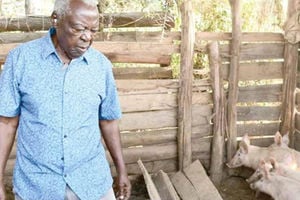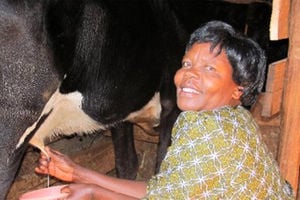
An energy efficient farm at Nakyesasa, which has efficient equipment and a well aerated environment. The roof has skylights, which improve lighting during day. PHOTO/GEORGE KATONGOLE
A new study conducted by Heifer International Uganda has revealed that the low adoption of solar power in the country's dairy sector is primarily attributed to high upfront costs. The report, titled Solar energy in the dairy sector in Uganda, emphasises the significant potential of solar technology to reduce milk wastage and enhance productivity within the dairy industry.
Dr Milton Ayoki from the Institute of Policy Research and Analysis, notes that the high upfront costs of solar PV technologies are a significant barrier to their widespread adoption in Uganda's dairy sector. For instance, powering a 6,000-litre milk cooler requires a solar system with 31kWp of solar modules, batteries, and other equipment, totalling approximately $101,500 (about (Shs372m). This substantial investment can be a challenge for rural cooperative societies.
The report, which analyses the energy needs of 210 dairy farmers, 32 milk transporters, and eight dairy cooperatives in Kiboga, Nakaseke and Ssembabule, emphasises the importance of addressing energy requirements throughout the dairy supply chain, from production to distribution.
He says: "Despite its numerous advantages, solar energy remains underutilised in the dairy sector. There is a need to increase awareness among farmers and stakeholders about the practical applications and benefits of solar power."
Challenges and opportunities
Uganda's dairy sector has witnessed remarkable growth in recent years, driven by increasing demand for milk and dairy products both domestically and regionally. However, as the industry expands, it faces a critical challenge: ensuring sustainable and efficient production practices.
One of the most pressing issues confronting dairy farmers in Uganda is the high cost and unreliability of traditional energy sources. Many farmers rely on diesel-powered generators for milk cooling, which can be expensive to operate and maintain. This not only erodes their profits but also contributes to environmental pollution. Solar energy offers a promising solution to these challenges.
Solar power can be used to power milk coolers, pump water for livestock, and even generate electricity for on-farm processing, making it a versatile and sustainable energy source for the dairy industry.
Uganda's total installed electricity generation capacity reached 1,182MW, comprising both grid-connected and off-grid sources. Hydropower remains the dominant source, accounting for 79.5 percent of the total capacity. However, there is a growing contribution from renewable energy sources, with solar PV representing 3.5 percent of the total capacity. Thermal power plants and bagasse co-generation contribute 8.7 percent and 8.2percent, respectively. The remainder is met through imported power from neighbouring countries and other sources.
Off-grid solution
Solar energy offers a critical solution to the problem of milk wastage in Uganda's dairy sector. Between 20-40 percent of the milk produced in the country is lost due to inadequate cooling facilities, which poses a significant economic burden.
Heifer International, with support from Powering Renewable Energy Opportunities (PREO), is implementing a two-year "Solar for Sustainable Income in Dairy (SSID) Project." This initiative brings together various stakeholders, including solar technology companies, impact investors, capacity builders, project financiers, dairy cooperatives and dairy processors, to promote the adoption of solar-powered rural milk chilling solutions.
Dr Ayoki recommends innovative financing models to facilitate the wider adoption of solar energy in the dairy value chain. He emphasizes the potential of captive solar systems, noting that the majority (69 percent) of installed systems are grid-tied, while 31 percent are off-grid, catering to areas with unreliable or no grid access.
The study highlights the relatively limited adoption of solar electricity in the dairy sector, with most applications focused on primary production and limited use in transportation and distribution.
Johnson Kwesigabo, chairman of the Dwaniro Dairy and Livestock Farmers Cooperative, shares his experience of initially overlooking solar as an option due to perceived high costs.
"When we first considered purchasing a generator, we didn't even think about solar as an option. We assumed it would be too expensive. Now, we realise that a solar system would be a much better investment. The generator should be the backup, not the primary source of power," Kwesigabo notes.
The Cattle Corridor, with a significant number of off-grid farms, presents a prime opportunity for solar adoption. Captive solar systems, particularly off-grid solutions, are well-suited for dairy production and collection in rural areas.
Unlocking the potential
Milk production has increased significantly, from 2.51 billion litres in 2018 to 3.2 billion litres in 2022, although the sector's productivity remains low compared to neighbouring countries.
Smallholder farmers, who make up the majority of the dairy industry, face significant energy challenges. Most cooperatives rely on diesel-powered generators for milk cooling, which are expensive to operate and maintain. The high cost of electricity and frequent power outages further erode farmers' income. Heifer International's SSID project aims to provide solar-powered equipment to dairy cooperatives and farmers and boost the incomes of over 2.7 million dairy farmers.
William Matovu, the Country Director for Heifer International Uganda, emphasises the significant benefits of solar energy in reducing costs, improving efficiency and enhancing the quality of dairy products.
"Addressing energy issues on dairy farms through solar energy is crucial for the sustainability of the sector, especially for off-grid farmers," Matovu says.
By introducing solar systems, Heifer International has helped farmers reduce their operating costs by up to 40 percent, improve milk cooling efficiency and limit spoilage. This has led to higher-quality milk, which commands premium prices from processors.
In a new scale up project, the Distributed Renewable Energy Ecosystem Model (DREEM) Hub project in Nakaseke District, Heifer international is working with the Mott Foundation to support the adoption of solar energy in agriculture. The hub offers farmers training, technical assistance, and financial products, such as lease-to-own models, to facilitate access to solar energy systems.
Edna Nyamwaka, a clean energy expert, emphasises the importance of increasing incomes for farmers, cooperatives, and processors while minimising environmental impact.
She highlights the role of viable financing mechanisms in achieving these goals.




